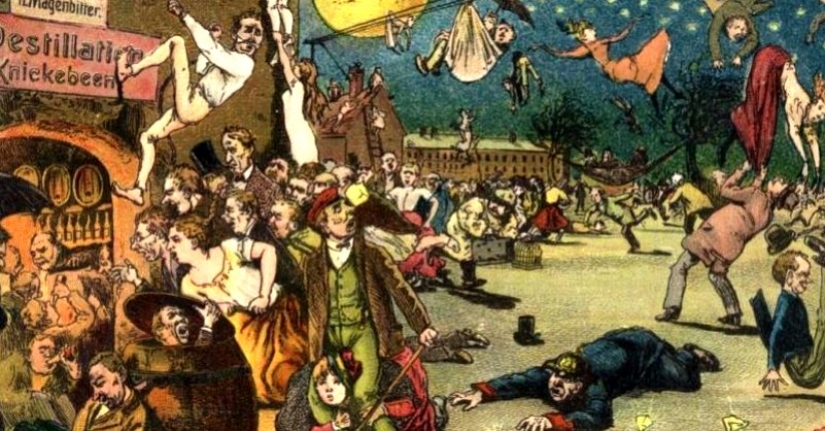Halley's Comet and the failed Apocalypse of 1910
Categories: Catastrophes | History
By Pictolic https://pictolic.com/article/halleys-comet-and-the-failed-apocalypse-of-1910.htmlIn 1910, the whole world was waiting for a guest from the depths of the universe – Halley's comet-to appear near the Earth. Scientists were waiting for him in anticipation of new discoveries, but most of the inhabitants of the planet perceived the approach of a celestial body as the beginning of a biblical Apocalypse. Religious fanatics and journalists did their best to incite panic, driving some impressionable people to real madness.

Halley's comet is not the first time it appears near the Earth. For the first time, its approach to the orbit of our planet was predicted by the outstanding astronomer and physicist of the 18th century, Edmond Halley. An Englishman in 1705 calculated that the comet would be near us in 1758 and was not mistaken. In his calculations, Halley relied on the laws of celestial mechanics, discovered by his countryman Isaac Newton.

In 1758, the comet appeared as scheduled and its tail was visible even to the naked eye, not only at night, but also during the day. Halley himself did not live to see this moment, but this important astronomical object was named after him. The next time the comet appeared was in 1835, and then 75 years later, in 1910.
Oddly enough, it was at the beginning of the progressive 20th century that some scientists suggested that a comet could bring death to all life on Earth and even destroy the planet. But astronomers and physicists expressed their assumptions in the walls of universities, observatories and scientific societies, and representatives of the press, as always, began to sow panic.

The journalists started in advance-back in 1907. It was then that an American newspaper published in Kentucky published an article under the screaming headline " Will the coming comet collide with the Earth?". In it, the newspaper asked astronomers whether there was a risk of a collision with a comet and received the answer that the probability of such an outcome is very small.
But the assurances of reputable scientists in the safety of the phenomenon did not bother anyone – the reaction was launched and many "experts" immediately rushed to comment on the upcoming meeting in space. Among the alarmists were several authoritative persons, for example, the French astronomer Camille Flammarion. He also claimed that there would be no collision of celestial bodies, but suggested that the Earth would pass through the tail of the comet and all living things would die, poisoned by poisonous gases-cyanogens.

This statement was picked up by newspaper scribblers and the very next day the New York Times was terrifying its audience of thousands:
Other publications did not lag behind, for example, the San Francisco Call newspaper reported that life on Earth is likely to disappear, but left a small loophole, adding that not all scientists are sure that there is a deadly gas in the tail of the comet. Panic gripped the world and enterprising people in the UK, USA, France and Russia immediately took advantage of it.

A huge number of various remedies that protect against the harmful effects of cyanogen have appeared on sale. The most insane, but nevertheless the most popular among the people were special umbrellas that protect against the effects of a comet and antidote pills that neutralize the poisonous cosmic gas. Is it worth saying that merchants have literally become rich on their goods.
In the resulting turmoil, scammers of all sorts rolled like cheese in butter and the police could not control them. Periodically there were news about the revelations, but it was a drop in the bucket. In 1909, the Texas police arrested two crooks who were making pills from pure sugar in their kitchen and selling them as an antidote for crazy money.
More practical means, such as military gas masks and chemical protection suits, were also in demand. Some residents of cities and villages were preparing for the disaster thoroughly, ordering special sealed windows and doors or sealing existing ones with rubber gaskets.

The writers did not miss their chance either. The author of wonderful books about Sherlock Holmes, Sir Arthur Conan Doyle, wrote a science fiction story "The Purple Fog", which, however, was published only in 1913. In it, the writer told the story of Professor George Edward Challenger, who predicted the passage of the Earth through a cloud of toxic cosmic ether. The scientist and his friends escaped from the poison in a specially prepared room, but it turned out that the gas only causes a deep sleep.
There were also supporters of another, more extreme version of the death of our planet. The Royal Observatory received a letter from a homegrown "genius of science", which outlined a detailed scenario for the end of civilization. The described pictures of destruction were amazing:

For a modern person, the mention of "a mass of chaotic disorder" will only cause a smile, but do not forget that it was the beginning of the 20th century and the letter gave the expected shoots. Someone at the Academy of Sciences leaked information and the next day this nonsense was replicated by dozens of newspapers.
On the date named by scientists in 1910, when Halley's comet approached the Earth, real chaos reigned in many cities. Religious processions and prayer services drowned out the howling of street whoops and the lamentations of outright lunatics, people in gas masks and simply with their faces wrapped in rags rushed through the streets, and the roads were crowded with carriages and carts of those who thought to escape from a catastrophe in the mountains or near the sea coast. As you know, everything ended in nothing.

The panic that arises in connection with the appearance of comets near the Earth was not something new. Even in ancient times, people expected only trouble from such meetings. In 700 AD, Bede, the Venerable Benedictine monk of the monastery of Saints Peter and Paul in the Anglo-Saxon kingdom of Northumbria, wrote:
This opinion was well illustrated in 1066, when Halley's comet once again appeared in the field of view of earthlings. In England, this year three monarchs claimed the throne at once and it became known as the"year of the three kings". In 1665, again during the passage of a comet, another outbreak of plague began in Europe. Around the same time, London suffered from the Great Fire of London.

There have been other cases involving other comets. But 1910 was a special year, because for the first time in history, forecasts were given not by churchmen, who repeatedly failed parishioners with false alarms,but by scientists. The influence of science at the turn of the 19th and 20th centuries was already very great, so there was a grandiose panic.
Halley's comet was supposed to pass near the Earth on May 18, 1910, and this day was filled with horror and despair. People gathered in crowds in cathedrals and just on the street, saying goodbye to each other and wringing their hands. But this day passed just like any other. On May 19, it was solemnly announced that the danger was over and everything was over.

Flammarion was put to shame, but the scientist was not going to give up. He collected a lot of eyewitness accounts that caught a slight smell of rotten vegetables, alcohol or acetylene, as well as data on people who suddenly became ill. The astronomer said that there was a cyanogen cloud, but the gas concentration was low.
Keywords: History | Disasters | Apocalypse | Scientists | Astronomy | Comet | Newspapers | Panic
Post News ArticleRecent articles

Most of us think that the color of the eggshell does not play any role and it is possible not to pay attention. But it's not and ...

The more we rely on technology, the more potential power hackers gain over us. It doesn't matter if their goal is to help or cause ...
Related articles

The Mongols seized in the 13th and 14th centuries, a large part of the Eurasian continent, was a force which could not to resist ...

A music album is not only a collection of tracks, but also an example of fine art. Each cover carries a certain meaning, and behind ...

In November 69 BC, she was born Cleopatra, the last Queen of Egypt from the Macedonian dynasty of the Ptolemies. Cleopatra, perhaps ...

Creating a good portrait is one of the most difficult tasks for any photographer. In order to make a really natural and memorable ...